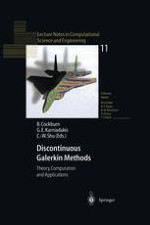A class of finite element methods, the Discontinuous Galerkin Methods (DGM), has been under rapid development recently and has found its use very quickly in such diverse applications as aeroacoustics, semi-conductor device simula tion, turbomachinery, turbulent flows, materials processing, MHD and plasma simulations, and image processing. While there has been a lot of interest from mathematicians, physicists and engineers in DGM, only scattered information is available and there has been no prior effort in organizing and publishing the existing volume of knowledge on this subject. In May 24-26, 1999 we organized in Newport (Rhode Island, USA), the first international symposium on DGM with equal emphasis on the theory, numerical implementation, and applications. Eighteen invited speakers, lead ers in the field, and thirty-two contributors presented various aspects and addressed open issues on DGM. In this volume we include forty-nine papers presented in the Symposium as well as a survey paper written by the organiz ers. All papers were peer-reviewed. A summary of these papers is included in the survey paper, which also provides a historical perspective of the evolution of DGM and its relation to other numerical methods. We hope this volume will become a major reference in this topic. It is intended for students and researchers who work in theory and application of numerical solution of convection dominated partial differential equations. The papers were written with the assumption that the reader has some knowledge of classical finite elements and finite volume methods.
